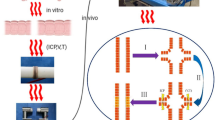Abstract
Clarifying changes in gastrointestinal tissue compressed by surgical stapler is a crucial prerequisite for stapler design optimization. For this study, a stapler was modified, and multifrequency bioimpedance of a porcine small intestine tissue compressed by the stapler was measured. The Cole Y model was fitted to the bioimpedance, and changes in tissue were analyzed using model parameters: G 0, extracellular fluid conductance; ΔG, intracellular fluid conductance; C cpeF, equivalent capacitance of cell membrane. The changes could be divided into two stages: first, all parameters decreased sharply with slopes more than 15.70 ± 2.67, 4.25 ± 1.23 μS/s and 72.68 ± 6.99 pF/s respectively; and subsequently, with an increase in compression strength, G 0 decreased with slopes less than 2.54 ± 0.40 μS/s, ΔG decreased slightly with slope of 0.26 ± 0.04 μS/s after fluctuating mildly, and C cpeF remained nearly invariant after initially increasing with slope of −2.94 ± 0.64 pF/s. In conclusion, when the stapler is closed, a portion of tissue is squeezed out of the measurement space, causing all parameters’ sharp decrease. Subsequently, the stapler continues compressing the tissue, leading to extracellular fluid expulsion. The changes in intracellular fluid are related to the compression strength and may be explained by cell restoration. This study could provide a basis for stapler design optimization.








Similar content being viewed by others
References
Ayllon D., F. Seoane, and R. Gil-Pita. Cole equation and parameter estimation from electrical bioimpedance spectroscopy measurements—a comparative study. Annual International Conference of the IEEE Engineering in Medicine and Biology Society, pp. 3779–3782, 2009
Baker, R. S., J. Foote, P. Kemmeter, R. Brady, T. Vroegop, and M. Serveld. The science of stapling and leaks. Obes. Surg. 14:1290–1298, 2004.
Chung, R. S. Blood flow in colonic anastomoses. Effect of stapling and suturing. Ann. Surg. 206:335–339, 1987.
Chung, R. S., D. C. Hitch, and D. N. Armstrong. The role of tissue ischemia in the pathogenesis of anastomotic stricture. Surgery 104:824–829, 1988.
Covidien. Instructions for Use: Surgical AutoSuture Versafires GIA Single-Use Stapler and Endo GIA Single-Use Loading Units. Norwalk, CT: United States Surgical Corporation
De Lorenzo, A., A. Andreoli, J. Matthie, and P. Withers. Predicting body cell mass with bioimpedance by using theoretical methods: a technological review. J. Appl. Physiol. 82(5):1542–1558, 1997.
Dodde, R. E., J. L. Bull, and A. J. Shih. Bioimpedance of soft tissue under compression. Physiol. Meas. 33:1095–1109, 2012.
Ethicon. Essential Product Information. Endopath® ETS Endoscopic Linear Cutters/Staplers. Cincinatti, OH: Ethicon Endo-Surgery Inc, pp. 1–5, 2002
Gonzalez-Correa, C. A., B. H. Brown, R. H. Smallwood, D. C. Walker, and K. D. Bardhan. Electrical bioimpedance readings increase with higher pressure applied to the measuring probe. Physiol. Meas. 26:S39–S47, 2005.
Gudivaka, R., D. A. Schoeller, R. F. Kushner, and M. J. Bolt. Single- and multifrequency models for bioelectrical impedance analysis of body water compartments. J. Appl. Physiol. 87:1087–1096, 1999.
Ishibashi, K., and S. Sasaki. Aquaporin water channels in mammals. Clin. Exp. Nephrol. 13:247–253, 2009.
Kawada, K., S. Hasegawa, K. Hida, K. Hirai, K. Okoshi, A. Nomura, J. Kawamura, S. Nagayama, and Y. Sakai. Risk factors for anastomotic leakage after laparoscopic low anterior resection with DST anastomosis. Surg. Endosc. 28:2988–2995, 2014.
Korolija, D. The current evidence on stapled versus hand-sewn anastomoses in the digestive tract. Minim. Invasive Ther. Allied Technol. 17:151–154, 2008.
Liu, B. W., Y. Liu, J. R. Liu, and Z. X. Feng. Comparison of hand-sewn and stapled anastomoses in surgeries of gastrointestinal tumors based on clinical practice of China. World. J. Surg. Oncol. 12:292, 2014.
Martinsen, O. G., and S. Grimnes. Bioimpedance and Bioelectricity Basics. Cambridge, MA: Academic Press, pp. 29–221, 2000
McGuire, J., I. C. Wright, and J. N. Leverment. An in vitro assessment of tissue compression damage during circular stapler approximation tests, measuring expulsion of intracellular fluid and force. Proc. Inst. Mech. Eng. H 215:589–597, 2001.
Morita, K., N. Maeda, T. Kawaoka, S. Hiraki, A. Kudo, S. Fukuda, and M. Oka. Effects of the time interval between clamping and linear stapling for resection of porcine small intestine. Surg. Endosc. 22:750–756, 2008.
Myers, S. R., W. S. Rothermel, Jr, and L. Shaffer. The effect of tissue compression on circular stapler line failure. Surg. Endosc. 25:3043–3049, 2011.
Nakayama, S., S. Hasegawa, K. Hida, K. Kawada, and Y. Sakai. Obtaining secure stapling of a double stapling anastomosis. J. Surg. Res. 193:652–657, 2015.
Nakayama, S., S. Hasegawa, S. Nagayama, S. Kato, K. Hida, E. Tanaka, A. Itami, H. Kubo, and Y. Sakai. The importance of precompression time for secure stapling with a linear stapler. Surg. Endosc. 25:2382–2386, 2011.
Pena A., M. Bolton, and J. Pickard. Cellular poroelasticity: a theoretical model for soft tissue mechanics. In: Poromechanics: Proceedings of the 1st Biot conference. Boca Raton: CRC Press, 1998, p. 475.
Rawlins, L., M. P. Rawlins, and D. Teel, 2nd. Human tissue thickness measurements from excised sleeve gastrectomy specimens. Surg. Endosc. 28:811–814, 2014.
Seoane F., R. Buendia, and R. Gil-Pita. Cole parameter estimation from electrical bioconductance spectroscopy measurements. In: Annual International Conference of the IEEE Engineering in Medicine and Biology Society, pp. 3495–3498, 2010
van Marken Lichtenbelt, W. D., K. R. Westerterp, L. Wouters, and S. C. Luijendijk. Validation of bioelectrical-impedance measurements as a method to estimate body-water compartments. Am. J. Clin. Nutr. 60:159–166, 1994.
Acknowledgments
This study was funded by the National Natural Science Foundation of China (No. 51377024), Natural Science Foundation of Shanghai (No. 14ZR1428300), and Science and Technology Commission of Shanghai Municipality (No. 13441900802).
Author information
Authors and Affiliations
Corresponding author
Additional information
Associate Editor Eiji Tanaka oversaw the review of this article.
Yu Zhou and Binbin Ren have contributed equally to this work.
Rights and permissions
About this article
Cite this article
Zhou, Y., Ren, B., Li, B. et al. Changes in Small Intestine Tissue Compressed by a Linear Stapler Based on Cole Y Model. Ann Biomed Eng 44, 3583–3592 (2016). https://doi.org/10.1007/s10439-016-1692-5
Received:
Accepted:
Published:
Issue Date:
DOI: https://doi.org/10.1007/s10439-016-1692-5




